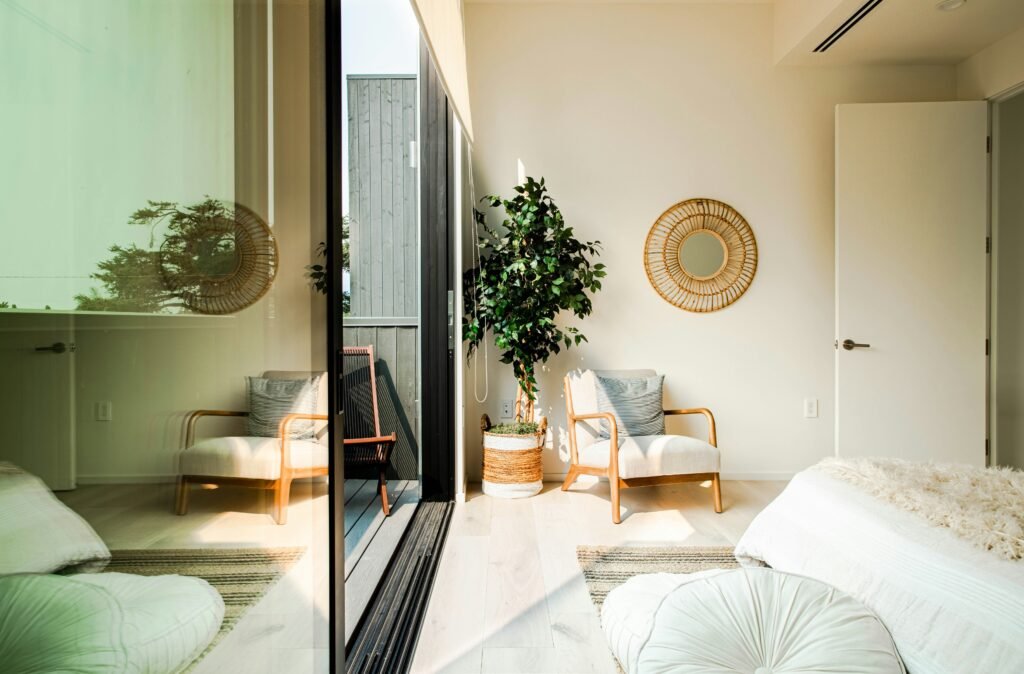?Want to make your small space feel larger using light?
What Lighting Ideas Make A Small Space Feel Bigger?
Why lighting matters in small spaces
Good lighting changes how you experience a room, and in a small space it can make the difference between feeling cramped and feeling open. With intentional lighting choices, you can control depth, define zones, and create the impression of height and breadth.
The basic principles to make a room feel bigger
Start by understanding a few core principles: increase brightness evenly, reduce harsh shadows, and draw the eye upward and outward. When you apply these ideas consistently, the room will read as larger and more comfortable.
Increase brightness without glare
You want the room bright enough to read and move comfortably, but not so bright that it feels clinical. Use multiple light sources and soft diffusion to avoid glare and maintain a relaxed atmosphere.
Reduce shadows and contrast
Deep shadows visually shrink space by breaking up surfaces and creating pockets of darkness. Minimize contrast by using ambient sources and wall-washing techniques that make surfaces read as continuous planes.
Draw the eye up and out
People perceive space vertically and horizontally. Lighting that emphasizes ceilings, upper walls, and outer edges makes the brain register more volume. Think about uplighting, cove lighting, and wall washers to lift the visual field.
Layering light: ambient, task, and accent
Layered lighting is essential for both function and perception. You should mix ambient, task, and accent lighting so each has a role in shaping how the room feels.
Ambient lighting: the foundation
Ambient light provides overall illumination and sets the mood. Use ceiling-mounted fixtures, recessed cans with diffusers, or large flush mounts to create an even base level of light.
Task lighting: purpose-driven illumination
Task lighting focuses on areas where you perform specific activities, like reading or cooking. Keep task lights focused and shadow-free so they improve usability without overwhelming the ambient layer.
Accent lighting: create depth and interest
Accent lighting highlights artwork, architectural features, or textural details to create visual layers. Use directional fixtures, picture lights, or low-power spotlights to add dimension without cluttering the room.
Maximize natural light
Natural light is the single most effective way to make a small space feel larger and more pleasant. You should aim to bring in as much daylight as possible and complement it with artificial sources for evenings and cloudy days.
Use window treatments strategically
Choose sheer or light-filtering curtains to let daylight in while maintaining privacy. Avoid heavy draperies that block light; instead, hang curtains close to the ceiling and extend them beyond the window frame to create the illusion of taller windows.
Keep windows unobstructed
Position furniture so it doesn’t block the window path of light, and use low-profile pieces near windows to allow sun to reach deep into the room. Reflective surfaces and light-colored floors can help bounce daylight around.

Mirrors and reflective surfaces
Mirrors are classic tools for visually expanding spaces, but their placement and finish matter. Use them to reflect both daylight and artificial light to double the perceived luminance and create extended sightlines.
Best mirror placements
Place a mirror opposite a window to reflect daylight back into the room, or position it to reflect a visually pleasing focal point to create depth. Consider oversized mirrors or mirrored panels to increase the impact without crowding the room.
Reflective finishes and materials
High-gloss cabinetry, metallic accents, or glass tabletops can scatter light and create subtle reflections that enhance perceived space. Be mindful of reflections that cause glare; choose finishes that reflect light softly.
Lighting fixtures that make small spaces feel larger
Choice of fixtures significantly affects perception. You should favor fixtures that are appropriately scaled, visually light, and designed to distribute light broadly rather than concentrating it in tight spots.
Recessed lighting and minimal profiles
Recessed cans are unobtrusive and keep the ceiling plane clean, which helps the room feel less cluttered. Use adjustable trims for task control and choose shallow cans for low ceilings.
Wall sconces and vertical illumination
Wall-mounted fixtures draw attention to vertical planes, making walls read taller and wider. Sconces that cast light both up and down help increase perceived height while adding ambient value.
Pendant lights and central fixtures
Select pendants with an open, airy design if you want a central focal point; avoid oversized pendants that overwhelm the space. Group small pendants or use a single slim-profile pendant to keep the ceiling visually light.
Floor and table lamps for zones
Slim floor lamps and compact table lamps provide localized light without blocking sightlines. Choose lamps with slim stems or open shades to maintain transparency and reduce visual clutter.
Color temperature and how it affects space perception
Color temperature influences mood and perceived spatial qualities. You should choose temperatures that enhance openness while matching the function of each area.
Warm vs cool tones
Cool white light (3500–5000K) tends to feel crisper and can make spaces feel more open and modern. Warm light (2700–3000K) feels cozier and might reduce the perception of space slightly, but it’s more flattering in living and sleeping areas. Use cooler temperatures in work areas and warmer tones in relaxation zones.
Use color consistency
Keep color temperature consistent across main light sources to avoid visual confusion and color shifts that fragment the space. If you mix temperatures, use them intentionally to separate zones or create contrast.
Lumen targets and brightness levels
Lumens measure perceived brightness and are more useful than watts when planning illumination. You should target appropriate lumen levels for each layer and room use.
Lumen recommendations by room and task
A clear guide helps you choose fixtures with the right light output so you don’t under- or over-light your space. Below is a practical table you can use when planning lumen counts.
| Room / Task | Recommended Lumens (total per room) | Notes |
|---|---|---|
| Living room (ambient) | 1,500–3,000 lm | Use layered lighting for flexibility |
| Living room (task) | 400–800 lm | Add reading lamps or focused fixtures |
| Kitchen (overall) | 4,000–8,000 lm | Higher levels for food prep and cooking |
| Kitchen (task, under-cabinet) | 300–800 lm per task area | Bright, shadow-free light on counters |
| Bedroom (ambient) | 1,000–2,000 lm | Softer ambient light preferred |
| Bedroom (task) | 300–700 lm | Reading lights by bed or desk lighting |
| Bathroom (vanity) | 2,000–4,000 lm | Even, front-facing light for grooming |
| Hallways | 100–200 lm per linear foot | Continuous, soft illumination |
| Home office | 3,000–6,000 lm | Higher general plus task lighting |
Balancing lumens across layers
Don’t rely on one high-lumen fixture; distribute lumens among fixtures and layers for even, comfortable illumination. Use dimmers to adjust total light output depending on time of day and activity.

Color rendering and bulb quality
Color Rendering Index (CRI) tells you how accurately a light source shows colors. You should prioritize bulbs with higher CRI to keep materials and skin tones looking natural in a small space.
Target CRI values
Aim for CRI 90+ for areas where color accuracy matters, like kitchens, bathrooms, and spaces with art or textiles. For general ambient lighting, CRI 80+ is typically acceptable and more budget-friendly.
How bulb quality affects perception
Poor color rendering can make surfaces look flat and lifeless, which reduces the sense of depth. Higher-quality LEDs with good CRI create richer contrasts and make the space feel more vibrant and alive.
Concealed and indirect lighting techniques
Indirect light expands perceived volume by softly illuminating ceilings and upper walls. You should use coves, valances, and uplights to create floating ceiling effects and gentle gradations of light.
Cove and soffit lighting
Cove lighting installed in a ceiling recess washes the ceiling with light and disguises edges, making the ceiling appear higher. This technique is particularly effective in rooms with low ceilings.
Backlighting and hidden sources
Light behind furniture, mirrors, or shelving creates a halo effect that separates objects from walls, producing depth without adding visual clutter. Use low-output LED strips or rope lights placed out of direct sight.
Using vertical and perimeter lighting
Lighting that emphasizes vertical surfaces and the perimeter of the room helps the eye read continuous planes and makes the room appear larger. You should combine wall washers and uplights to highlight vertical space.
Wall-washing techniques
Position linear or adjustable fixtures close to walls to evenly illuminate them and reduce texture shadows. Wall-washing minimizes breakup of surfaces and increases perceived width.
Perimeter floor and toe-kick lighting
Low-level perimeter lighting along baseboards or under cabinets extends visual boundaries and creates a floating effect for furniture and cabinets. This subtly enlarges the perceived footprint of the room.
Smart controls and dimming
Smart controls give you the power to tune light levels, color temperature, and scenes throughout the day. You should use dimmers, timers, and programmable scenes to adapt illumination and keep the room feeling open at every hour.
Benefits of dimming and scenes
Dimmers help reduce contrast and permit you to soften lighting in the evening, which can actually make the space feel more continuous. Scene controls let you pre-set combinations for work, relaxation, or entertaining without fuss.
Circadian-friendly lighting
You can program warmer, lower light in the evening and brighter, cooler light in the morning to support natural rhythms. This not only enhances comfort but keeps the space functioning well for various activities.

Fixture selection: size, transparency, and scale
Choose fixtures that are proportional to your room size and visually light. You should avoid heavy, oversized fixtures that dominate the visual field and make the space feel cluttered.
Proportions for small rooms
Opt for slim profiles, narrow stems, and smaller diameters for pendants and chandeliers. Clear materials and openwork designs reduce visual mass while still providing impact.
Materials that read lighter
Glass, thin metal frames, and openwork shades let light travel through and around fixtures, preserving sightlines and preventing a heavy look. Matte black or dark fixtures can work if balanced with sufficient brightness and reflective surroundings.
Practical lighting solutions by room
Different rooms require tailored strategies. You should prioritize light where activities occur, while using other layers to promote openness.
Living room strategies
Use a central ambient source plus wall washers and reading lamps for zones. Keep fixtures low-profile and place a mirror on an opposite wall to amplify light.
Bedroom strategies
Combine soft ambient light with bedside reading lamps and indirect uplighting for a cozy but spacious feel. Use dimmers to switch between functional and relaxing scenes.
Kitchen strategies
Maximize task lighting with under-cabinet strips and recessed fixtures over work zones, then add uplighting to expand the vertical space. Keep countertops clutter-free to allow light to reach surfaces.
Bathroom strategies
Illuminate the vanity evenly with paired sconces or a wide horizontal light to avoid shadows. Consider a backlit mirror to add floating depth and maintain a clean sightline.
Hallways and entryways
Use continuous, even lighting along corridors to create the impression of length and openness. Recessed or linear fixtures flush with the ceiling avoid lowering the perceived height.
Lighting plans and layout tips
A simple plan can guide effective placement and prevent surprises. You should measure, map out furniture, and allocate fixture types by zone before buying or installing anything.
Start with a room sketch
Draw a basic floor plan with furniture layout and mark intended activities to determine where task lighting is essential. Note windows and door swings so fixtures don’t create conflicts.
Mark circuit and switch locations
Think about where switches should be placed for convenience and what groups of lights you want on the same control. Consider multiple switch locations for large rooms and three-way circuits for key entries.
Common mistakes to avoid
Some common lighting errors actually make a small space feel smaller. You should be aware of these pitfalls so you can avoid them in your design.
Relying on a single overhead fixture
A single central light often creates unflattering shadows and an uneven brightness field. Layer multiple sources instead to create balance and depth.
Using fixtures that are too large or ornate
Oversized fixtures draw visual attention and can dwarf a small room. Choose proportionally-sized fixtures and simpler silhouettes.
Placing lights without considering furniture
Fixtures that collide with the lines of furniture or block sightlines will create a cramped feeling. Plan placement in relation to key furniture pieces and walking paths.
Energy efficiency and maintenance
Good lighting is efficient and low maintenance, which keeps your room bright without high costs or frequent service. You should aim for long-life LEDs and easily accessible fixtures.
Choose efficient LEDs
Modern LEDs offer high lumen output at low wattage, long life, and good color rendering. Select fixtures that accept common LED modules and are compatible with dimmers and smart controls.
Maintain fixtures and bulbs
Keep diffusers, shades, and bulbs clean to preserve lumen output; dust and dirt can noticeably reduce brightness. Replace aging bulbs in matched color temperatures to maintain consistency.
Budgeting and shopping tips
You don’t need to spend a lot to achieve big results, but smart choices maximize impact. You should prioritize key fixtures and use simple accessories to stretch your budget.
Where to invest
Invest in high-quality ambient fixtures, accurate color-rendering bulbs, and dimming controls. Save on decorative elements by choosing simple, well-placed accent pieces.
Sample budget allocation
A practical allocation might be 40% for ambient fixtures, 25% for task lighting, 15% for accents and controls, and 20% for installation and unexpected costs. Adjust based on room importance and functionality.
Quick checklist before installation
Use this checklist to ensure your lighting plan meets your goals and avoids common issues. You should confirm measurements, placement, and fixture capabilities before installation.
- Measure ceiling height and room dimensions
- Map furniture and activity zones
- Choose appropriate lumen targets for each area
- Select bulbs by CRI and color temperature
- Ensure fixtures fit scale and style
- Plan switch and control locations
- Verify compatibility with dimmers and smart systems
- Schedule installation and check local electrical codes
Case studies: small spaces transformed by light
Real-world examples help you see how strategies translate into practice. You should consider these scenarios as templates for your own room.
Studio apartment: open-plan brightness
In a studio, combine recessed ambient lighting with floor lamps at opposing corners and a large mirror opposite the window. Use under-cabinet and shelving backlighting to create distinct zones without physical dividers.
Narrow hallway: lengthened with linear light
Install a continuous LED strip in a ceiling cove or linear recessed fixtures to create a ribbon of light. Add a mirror at the far end to reflect the line and amplify perceived length.
Small kitchen: worked corners and floating cabinets
Under-cabinet LEDs and toe-kick lighting illuminate countertops and extend visual boundaries. Floating upper cabinets with uplighting behind them make the ceiling appear higher and the room less crowded.
Installation and safety considerations
Electrical work should meet local codes, and some tasks are best left to licensed electricians. You should be mindful of clearances, thermal ratings, and secure mounting.
Key safety points
Ensure fixtures are rated for the location (e.g., damp-rated for bathrooms), and verify wiring capacity for added loads. Use proper connectors, enclosures, and follow fixture manufacturer instructions.
When to call a pro
Call a professional if you need new circuits, ceiling-mounted boxes, or if your plan requires complex control wiring. A pro can also advise on placement to optimize both performance and aesthetics.
Final tips to make light work for you
Small changes can have large effects: move a lamp, swap a bulb, or add a mirror to test the impact. You should experiment with scenes and dimming to find the combos that make your space feel most open and comfortable.
Start small and iterate
Try temporary adjustments before committing—move lamps, test different bulbs, and borrow a mirror to see the effect. Gradual changes let you refine the plan and avoid costly mistakes.
Keep consistent visual language
Stick to consistent finishes and color temperatures for main light sources to maintain a cohesive look. A harmonious palette and balanced brightness will help your small space feel intentional and spacious.
Summary
Lighting is one of the most powerful tools for making a small space feel bigger, and it’s accessible with thoughtful planning and a few strategic investments. You should layer ambient, task, and accent lighting; maximize natural light and reflections; choose appropriate color temperature and CRI; and use concealed and vertical lighting techniques to expand perceived space.
If you follow these guidelines, your small room will feel brighter, more open, and better suited to how you live.
